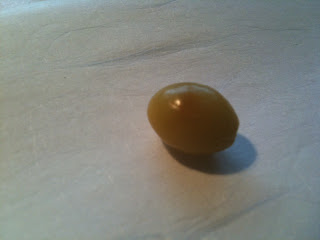First, a little botany lesson. Because I love ginkgo trees.
Their leaves are so pretty!
Ginkgo trees are classified as gymnosperms, which is the older method of seed-bearing among plants. Conifers are another common example (I'll refrain from geeking out about the cycads...just know that you never want to hit the botanic gardens with me).
Basically, it means their seeds aren't enclosed inside a flower, and instead are in cones or exposed on short stalks. And it means ginkgo trees are extremely ancient. That "living fossil" stuff biology teachers get excited about? That's the ginkgo.
More ginkgo porn. So pretty.
People have been noshing ginkgo biloba seeds for a long time, particularly in Asia. And it just so happens that the DC area is full of ginkgo trees, and that fruiting season is right now. In addition to the pretty leaves, you'll know these trees by the foul odor emanating from the sidewalk, and the squashed orange goo everywhere. Yes, the fruit reeks. But it's also a nice glowy orange color, and adorably wrinkled.
Naturally, I have some around the corner from my house in their full reeky glory. So I had to investigate. I just foraged them from the ground, because the putrescent flesh isn't what we're after anyway.
At this point, I had to consult the internets for advice, having neither tasted ginkgo nuts before nor any idea what to do with them. Instructables to the rescue!
Following the tutorial's advice, I soaked the fruit for an hour in warm water, then removed the seeds. (Also do be aware that ginkgo fruit technically contains urushiol, aka the chemical that puts the "poison" in poison ivy. I've never had issues, but if you're paranoid/sensitive/not a risk-taker, glove up)
This is what they look like, de-fruited.
I wanted to consume them right away, so I skipped ahead to roasting them in the oven. I cooked them at 400 degrees for just over ten minutes, not quite sure how to tell if they were done, because the outer shell does not turn green, just the inner meat. The explosion solved my little dilemma.
Seriously, if you want to scare someone, explode some ginkgo seeds in their oven. It sounded like a cannon went off in there. Maybe I'd try a lower heat next time, but the survivors were indeed done.
They look like slightly translucent olives when cooked and peeled.
And the taste? That was what I was most curious about, since most people dislike them or claim they're an acquired taste. The short version would be "they taste like buckwheat-flavored jelly beans". But they're actually pretty complex- kind of woodsy and earthy, with an odd chewiness. The second one I ate was significantly more bitter than the first, but there's a touch of bitterness to all of them. On top of all that, the toasty buckwheat flavors resound most prominently.
I'm not sure what to do with them next. Most recipes I see them in are very strange to the western palate- congee, eggy savory custards, and the like. I'm going to think about it and hopefully come up with something good. The flavor is unique enough make all the effort worthwhile at least a few times each year.
Thursday, October 20, 2011
Subscribe to:
Post Comments (Atom)






No comments:
Post a Comment